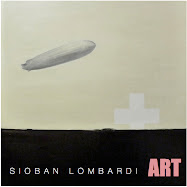
This is an attempt to understand my role and responsibility as a woman attempting to exist as an artist in 2009. I am not speaking of fame or a retrospective at MOMA. I am speaking of earning a living as a working artist. I have been reading Wet written by Mira Schor and From the Center, Lucy Lippard’s essays on Feminist Art. I value reading these works 25 years after college with some life experience under my belt.
As an undergrad at an all women’s liberal arts college during the Reagan years, the flutter blustered around Judy Chicago’s celebrated Dinner Party, now permanently ensconced at The Brooklyn Museum. What now strikes me is the impression that a woman artist identified notable women as dinner plates and vaginas. I rarely feel objectified, but feel this sting each time I now reflect on the work. I hope I am more than these two components. In addition, and new to mind, is the awareness of the Hegelian subject-object relationship made manifest in the anonymity of artisans that crafted the work appropriated by the author.
In fact, almost all circumstances of objectification that I’ve experienced have come from the “other”. While I agree with Simone de Beauvoir on the theory that men had constructed the mystery of the “other”, I believe that women have cultivated it. One reason that patriarchy continues is that women adapt it, with their own methods of assassination, for their own use. As evidenced in, marketing, branding and celebrity, they are complicit. One graduate professor I recently encountered, a woman artist of some talent and acclaim, felt it necessary to share with me, in a disparaging tone, that Helen Frankenthaler had her nylons pressed. Indeed, she encouraged her students to attend a lecture of David Salle’s. I happen to be in the camp that David Salle is a misogynist; I also believe that his is learned behavior. For me much of the feminist art of the 1970’s is akin to screaming at a dyslexic for poor sentence structure.
It is not a surprise that so many women that I went to college with, after championing the women’s movement, opted out, for the perceived comfort and protection of suburban life. I think of Hannah Wilke’s work and can’t help but rue the posthumous acceptance of her work by a substantial number of women artists. This occurred only when she was no longer young, beautiful and naked, but swollen, disfigured and dead.
In my own attempts at editorializing socio-political issues I fall short, either due to my own lack of experience, the immaturity of my opinion, or my continued ambiguity for the referenced experience. So often I find feminist art rages even at its constituency. I wholeheartedly support freedom of choice, but based on my experience, a sterile suction curette, no matter how available, is as emotionally charged as a coat hanger.
Thus, I am attempting to document my own experience regarding those eternally grand themes artists encounter: life, death, love, hate, sin, despair and even happiness. A twice-monthly series of paintings attempts to honestly examine my aging body; a recent installation of t-shirts accompanied by personal wish-list addresses my greed; another installation of test tubes reflects the clinical detachment I felt watching someone die.
I am also assessing some Biblical themes. A current painting is based on the Annunciation. The Virgin is a pair of denim-clad legs. The Archangel is represented as a black raven. Archangels are bad-asses and as purely spiritual and intellectual beings – not particularly gender based. A Seed, is represented as a piece of frosted layer cake. Being informed of a virgin birth would be frightening for any woman, but if you believe Christian myth, and some of it I do, only a woman had God in her and on her and from her.
This notion speaks to what is most necessary in art today: clarity and quality of content, intent and production. In addition, there must exist an interaction with the observer that demonstrates respect and requires their participation. Whether abstract or representational, male or female, gay or straight, the ghettoizing aspect of artistic subcultures is tiresome and worn. There is also nothing new. As an artist, I don’t need to strap on a strap-on as was necessary at the time it was necessary. But, if only I am speaking, I can’t hear you and if I cannot hear you, there is no discourse. Everything will stay the same. I look forward to hearing you.



No comments:
Post a Comment